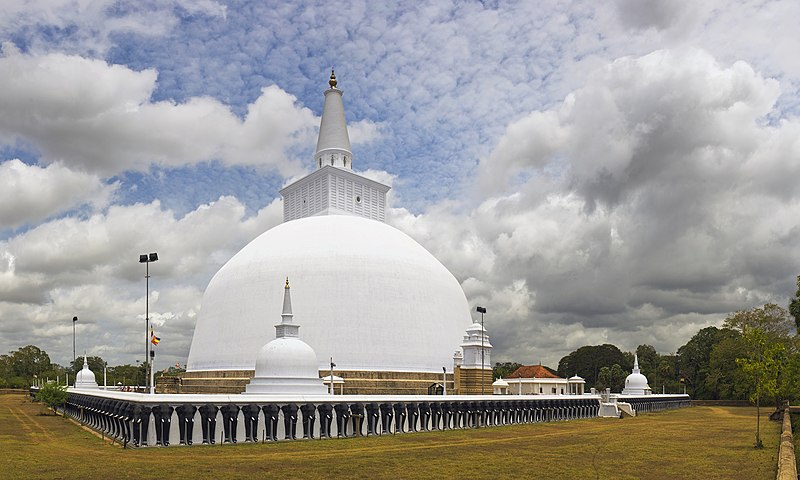IN03100 Alutväva Pillar Inscription
The inscription is engraved on three sides of a quadrangular stone pillar found at Alutwväva (Alutwewa, a hamlet near Eppavala), where it was examined by H. C. P. Bell in 1895. The text gives details of a council warrant. Certain portions of the text are no longer legible and, as a consequence, the exact purport of the warrant is unclear. The readable part of the inscription enumerates certain properties in Mahademeṭi-kuḷiya, which are described as being under the management of one Tinḍī Kitu. However, given the damage to the text, it is not possible to say whether the properties were gifted to this man or whether he only received certain privileges in connection with them.
The inscription gives the date upon which the warrant was approved and the date upon which it was proclaimed. Both dates are in the lunar month Und-väp (Nov.-Dec.) in either the fifth or the twentieth (the text is not entirely clear) regnal year of king Siri San̆g-bo. The biruda Siri San̆g-bo was used by several Sri Lankan kings. Dating the inscription on palaeographic grounds to around the tenth century A.D., Wickremasinghe suggests that Siri San̆g-bo refers in this instance to either Sena II (r. 866-901 A.D.) or Kassapa IV (r. 912-929 A.D.), both of whom are known to have used the title. The palaeography more strongly supports the case for Kassapa IV but, of the two, only Sena II ruled for more than twenty years, making him the likelier possibility if the regnal year is interpreted as ‘twentieth’, rather than ‘fifth’.
OB03077 Räkiṭipe Pillar Fragment of Līlāvatī
IN03097 Räkiṭipe Pillar Inscription of Līlāvatī
The inscription is engraved on a stone fragment found between the years 1906 and 1912 in the village of Räkiṭipe in Unantänna-vasam, Diyatilaka kōrale in the Nuvara Eliya District. The abrupt ending of the inscription and the sun and moon emblems carved above the text indicate that the stone originally formed the top of a square pillar. The rest of the pillar is missing. As the extant fragment features only the first ten lines of the inscription, it is not possible to say what the subject-matter was. However, it seems from the first clause that the inscription recorded a grant of land or some other benefaction in the reign of Līlāvatī, the Queen-dowager of Parakkama-Bāhu I who ruled as sovereign in her own right for three separate periods, first in 1197, then in 1209-10 and finally in 1211-12. On the basis of palaeographic considerations, Wickremasinghe conjectures that this inscription may date to 1211 A.D., when Līlāvatī was installed on the throne for the third time, governing for seven months until deposed by the Pāṇḍyan King Parakkama.
OB03067 Poḷonnaruva Rankot-Dāgaba Pillar
Rankoth Vehera, Polonnaruwa.
IN03087 Poḷonnaruva Rankot-Dāgaba Pillar Inscription
The inscription is repeated on each of the four pillars which once supported the roof of an open pavilion on the southern terrace of the Ruvanväli or Rankot-dāgaba in Poḷonnaruva. According to the inscription, this pavilion was built to provide a place from which king Niśśanka Malla could pay his adorations to the relics enshrined in the dāgaba. Presumably, the pavilion originally contained an āsana (throne) or dias for this purpose. The pillars are square at the top and bottom with an octagonal section in the centre. All four pillars are fallen and two are broken. The inscription gives an account of some of Niśśaṅka-Malla’s acts, before describing the king’s use of the pavilion. Niśśaṅka-Malla reigned from 1187 to 1196 A.D. No specific date is given in the inscription but, as Wickremasinghe notes, the text must have been composed after the fourth year of Niśśaṅka-Malla’s reign because it refers to the king’s visit to Anurādhapura, which took place in his fourth regnal year, and to his later tours of inspection.
Of the four copies of the inscription on the four pillars, two were first transcribed and translated by Rhys Davids in 1875 for the Journal of the Royal Asiatic Society. The third copy was edited by Müller in Ancient Inscriptions in Ceylon (1883). The information below relates to the fourth copy, which was transcribed and translated for the first time by Wickremasinghe in Epigraphia Zeylanica 2 (1912-27). The fourth copy differs from the other three in the number of lines on each side and also in the beginning and end of each line.
OB03062 Poḷonnaruva Niśśaṅka-Dāna-Vinoda-Maṇḍapa Pillar Fragment
IN03082 Poḷonnaruva Niśśaṅka-Dāna-Vinoda-Maṇḍapa Inscription
The inscription is engraved on two sides of the upper portion of the shaft of a stone pillar. It was seen by Wickremasinghe in Archaeological Commissioner’s Office at Tōpaväva in Poḷonnaruva sometime before 1927, having been discovered by S. M. Burrows in 1885-6. The inscription consists of 12 lines and records that a pavilion called Niśśaṅka-dāna-maṇḍapa was constructed for the purpose of witnessing the great rejoicings of the beggars who had received alms from the king Niśśaṅka-Malla. It is therefore quite obvious that this inscription dates from the reign of Niśśaṅka-Malla (1187-1196 A.D.) and originally stood somewhere at the entrance to the Niśśaṅka-dāna-maṇḍapa. Burrows found the pillar-fragment in a ruined building, with massive pillars, abutting on the bund of Tōpa-väva tank in Poḷonnaruva and consequently identified this building as the Niśśaṅka-dāna-vinpoda-maṇḍapa (‘the pavilion for the past-time of Niśśaṅka-almsgiving’). This identification was confirmed in 1902 by H. C. P. Bell, whose excavations revealed that the building originally stood at the centre of quadrangular terraced platforms and had therefore been well suited for witnessing the distribution of alms.
Pauni (पवनी Bhandara district). Memorial Pillar (OBNAG0032) with Inscription (INNAG0031) of Rupiamma
Pauni (पौनि Bhandārā district) Maharashtra.

Tablet with half-lotus decoration and inscription of Rupiamma. Nagpur Central Museum (Maharashtra)

